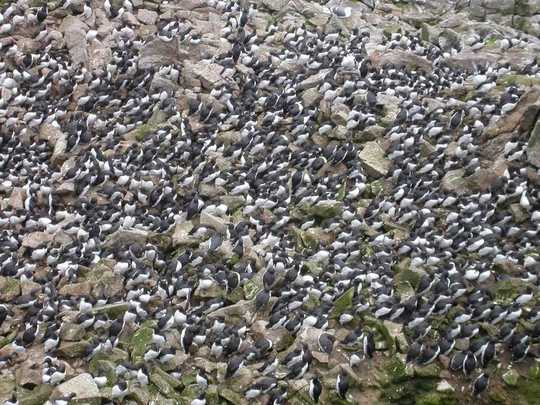 A common guillemot colony on the Farallon Islands, California. Duncan Wright/Wikipedia, CC BY-SA
A common guillemot colony on the Farallon Islands, California. Duncan Wright/Wikipedia, CC BY-SA
The common guillemot (known as the common murre in North America) breeds in both the Pacific and the Atlantic and is among the most abundant seabirds in the northern hemisphere. But like many other seabirds, its numbers have declined over the last few decades. Part of that decline is due to the marine environment – a seabird’s home and hunting ground – becoming increasingly unpredictable and difficult to survive in.
Between the summer of 2015 and the spring of 2016, a marine heatwave swept the northern Pacific Ocean that was hotter and lasted longer than any since records began in 1870. Known as “the blob”, the heatwave caused sea surface temperatures along the Pacific coast of North America to rise by 1-2°C. That may sound trivial, but it was enough to cause massive disruption in the marine ecosystem. The fish that common guillemots normally eat, such as herring, sardine and anchovy, either died or moved into cooler waters elsewhere, leaving the guillemots with little to eat. As a result, many birds starved.
 On January 1 and 2 2016, 6,540 common guillemot carcasses were found washed ashore near Whitter, Alaska. David B. Irons, CC BY
On January 1 and 2 2016, 6,540 common guillemot carcasses were found washed ashore near Whitter, Alaska. David B. Irons, CC BY
A new study has revealed that one million common guillemots died due to the heatwave, and two thirds of them are thought to have been breeding adults. In a healthy population, about 95% of the breeding birds survive from one year to the next. But a bad year for adult survival causes big problems for the total population.
This is because guillemots live up to 40 years and mature slowly, producing a single egg per annual clutch. A female may start breeding at the age of seven and continue to breed each year until she dies. Most seabirds live similar lives because the food on which they rear their offspring is often a long way from land. Ferrying food back to the breeding colony is what limits how many offspring they can rear in any one year. Rearing just a single chick at a time makes sense, but if many adult birds of reproductive age die, there are no new chicks to replace those birds that are lost, and so the population declines.
Seabirds wrecked by ocean warming
Researchers based the estimate of one million dead guillemots on the numbers of dead or dying birds that washed up between California and the Gulf of Alaska. A total of 62,000 birds were found on 6,000km of coastline, but not all birds that die at sea end up on beaches. Previous studies have shown that the number of birds actually found dead needs to be multiplied by at least seven times – and possibly as much as several hundred times – to find the minimum estimate of the total numbers dead. That means that “one million dead seabirds” might actually be a conservative guess.
According to the new study, breeding populations in the Gulf of Alaska suffered a 10-20% decrease in numbers. Complete breeding failure, where birds either failed to lay eggs or failed to rear any chicks, was reported at 22 regularly monitored guillemot colonies in Alaska during the breeding seasons of 2015, 2016 and 2017. Complete breeding failure is extremely unusual among guillemots and it’s a clear sign that food is in extremely short supply.
 Temperatures in the northeast Pacific Ocean broke records during the 2015-2016 heatwave. NOAA
Temperatures in the northeast Pacific Ocean broke records during the 2015-2016 heatwave. NOAA
The appearance of unusually high numbers of dead birds washed up on the shoreline is referred to as a “wreck”. Wrecks of common guillemots and related species such as puffins have been known about for many years. These population crashes may be a regular aspect of guillemot biology, but this one was far larger and over a much wider geographic area than any wreck seen before.
In most cases, wrecks are the result of persistent stormy conditions, disrupting the availability of fish on which seabirds like guillemots and puffins depend. When seas are rough and the weather harsh, the increased energy demands can kill many birds. The most recent wreck in the UK and western Europe occurred in the spring of 2014, and it killed at least 50,000 birds, mainly common guillemots and Atlantic puffins.
The common guillemot populations in the Pacific and western Europe will probably recover from both of these recent wrecks, providing there’s no further turmoil, but there’s no room for complacency. The only way scientists will know if populations have recovered is by monitoring the birds. It’s an activity that is generally regarded as the lowest form of scientific endeavour, but one that’s absolutely vital in a world of declining wildlife.
 Tim Birkhead and his field assistant Dr Jess Meade on Skomer in 2012. Tim Birkhead, Author provided
Tim Birkhead and his field assistant Dr Jess Meade on Skomer in 2012. Tim Birkhead, Author provided
I’ve been studying and monitoring the number of common guillemots on Skomer Island, Wales since 1972. In that time, I’ve realised how essential this work is to understanding how guillemot populations work. Beach counts of dead seabirds allow scientists to detect unusual events, but these counts are meaningless without information on the overall size of the population. Without regular monitoring of seabird colonies on North America’s west coast, the researchers wouldn’t have known what proportion of the total population died, and would have missed the total breeding failures in the Alaskan colonies.
The North Pacific common guillemot wreck was unprecedented for the sheer numbers of birds killed, and the vast region over which it occurred. But the marine heatwave that caused it may be just a taste of what is to come for seabirds around the world as climate change accelerates.
About The Author
Tim Birkhead, Emeritus Professor of Zoology, University of Sheffield
This article is republished from The Conversation under a Creative Commons license. Read the original article.
Related Books
Life After Carbon: The Next Global Transformation of Cities
by Peter Plastrik , John Cleveland The future of our cities is not what it used to be. The modern-city model that took hold globally in the twentieth century has outlived its usefulness. It cannot solve the problems it helped to create—especially global warming. Fortunately, a new model for urban development is emerging in cities to aggressively tackle the realities of climate change. It transforms the way cities design and use physical space, generate economic wealth, consume and dispose of resources, exploit and sustain the natural ecosystems, and prepare for the future. Available On Amazon
The future of our cities is not what it used to be. The modern-city model that took hold globally in the twentieth century has outlived its usefulness. It cannot solve the problems it helped to create—especially global warming. Fortunately, a new model for urban development is emerging in cities to aggressively tackle the realities of climate change. It transforms the way cities design and use physical space, generate economic wealth, consume and dispose of resources, exploit and sustain the natural ecosystems, and prepare for the future. Available On Amazon
The Sixth Extinction: An Unnatural History
by Elizabeth Kolbert Over the last half-billion years, there have been Five mass extinctions, when the diversity of life on earth suddenly and dramatically contracted. Scientists around the world are currently monitoring the sixth extinction, predicted to be the most devastating extinction event since the asteroid impact that wiped out the dinosaurs. This time around, the cataclysm is us. In prose that is at once frank, entertaining, and deeply informed, New Yorker writer Elizabeth Kolbert tells us why and how human beings have altered life on the planet in a way no species has before. Interweaving research in half a dozen disciplines, descriptions of the fascinating species that have already been lost, and the history of extinction as a concept, Kolbert provides a moving and comprehensive account of the disappearances occurring before our very eyes. She shows that the sixth extinction is likely to be mankind's most lasting legacy, compelling us to rethink the fundamental question of what it means to be human. Available On Amazon
Over the last half-billion years, there have been Five mass extinctions, when the diversity of life on earth suddenly and dramatically contracted. Scientists around the world are currently monitoring the sixth extinction, predicted to be the most devastating extinction event since the asteroid impact that wiped out the dinosaurs. This time around, the cataclysm is us. In prose that is at once frank, entertaining, and deeply informed, New Yorker writer Elizabeth Kolbert tells us why and how human beings have altered life on the planet in a way no species has before. Interweaving research in half a dozen disciplines, descriptions of the fascinating species that have already been lost, and the history of extinction as a concept, Kolbert provides a moving and comprehensive account of the disappearances occurring before our very eyes. She shows that the sixth extinction is likely to be mankind's most lasting legacy, compelling us to rethink the fundamental question of what it means to be human. Available On Amazon
Climate Wars: The Fight for Survival as the World Overheats
by Gwynne Dyer Waves of climate refugees. Dozens of failed states. All-out war. From one of the world’s great geopolitical analysts comes a terrifying glimpse of the strategic realities of the near future, when climate change drives the world’s powers towards the cut-throat politics of survival. Prescient and unflinching, Climate Wars will be one of the most important books of the coming years. Read it and find out what we’re heading for. Available On Amazon
Waves of climate refugees. Dozens of failed states. All-out war. From one of the world’s great geopolitical analysts comes a terrifying glimpse of the strategic realities of the near future, when climate change drives the world’s powers towards the cut-throat politics of survival. Prescient and unflinching, Climate Wars will be one of the most important books of the coming years. Read it and find out what we’re heading for. Available On Amazon
From The Publisher:
Purchases on Amazon go to defray the cost of bringing you InnerSelf.comelf.com, MightyNatural.com, and ClimateImpactNews.com at no cost and without advertisers that track your browsing habits. Even if you click on a link but don't buy these selected products, anything else you buy in that same visit on Amazon pays us a small commission. There is no additional cost to you, so please contribute to the effort. You can also use this link to use to Amazon at any time so you can help support our efforts.























